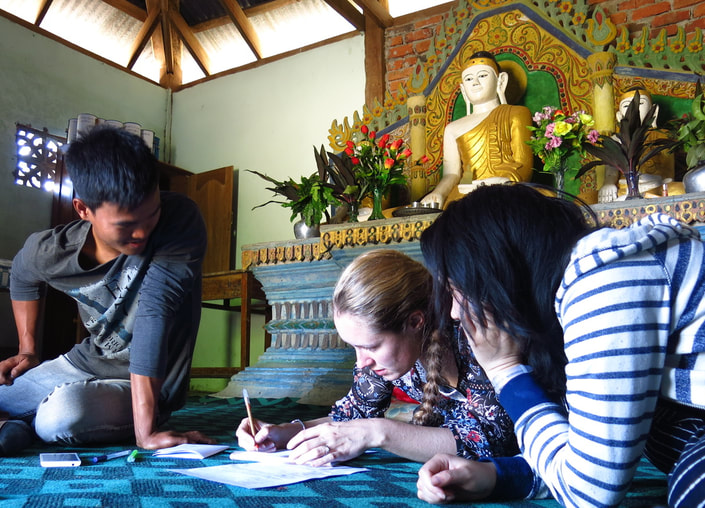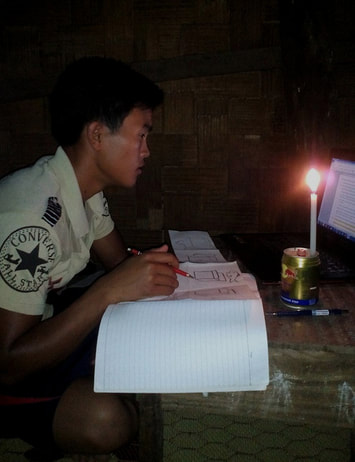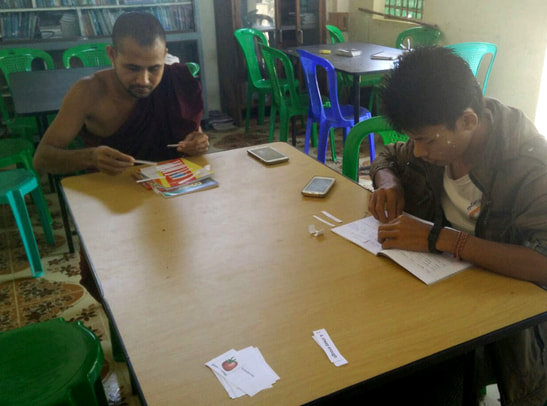|
The head monk wants more lessons. He wants conversation held with all of the students. I see why. He has a foreigner in the village and during one conversation with my trainee the monk mentioned equality and fairness. You see, we only teach 3 days a week. Teacher training is intensive. The best lessons are those which have been planned for hours. Currently planning takes around 6 hours for every 1.5 hour lesson. The more simple, the more natural and easy a lesson seems to the student, the more planning has happened behind the scenes. Training in a second language is harder still. I’m sure the monk thinks that my trainee is using me for his own personal benefit on the 4 non-teaching days. That instead of slaving over context and concepts we sit round sipping tea and improving the English of one member of the village. I mean, of course, his English is improving. Naturally. All I do is talk about grammar and lesson planning. His vocabulary is increasing, albeit in a very specific lexical field! The monk wants all of the students to benefit. I think that this is very noble and I fully understand why he wants this for his pupils. That’s why this is so hard. It’s not an unreasonable thing that he wants done. It’s just that it is. Unreasonable I mean when there’s only one of me. We are teaching a 16 hour in-class week and that is plenty for a new teacher; full time is 20 in-class hours. The 4 non-teaching days are spent pouring over books, dissecting the previous lesson in painful detail; giving harsh feedback in which my trainee is never satisfied with his own performance. Like any passionate teacher, he always feels it could have gone better. However, the actual improvement part is something that we are still working on. We re-plan the previous lesson with the new parts gleaned from teaching to the grade 9 guinea pigs. We then move on to the next part in the series. The context is crucial. I often find myself with a gaggle of ideas and activities that I want the students to do; what takes time is setting those up in a way that makes it easy for the students to use and retain the new language. The scaffolding of active learning takes patience and experience. I knew I was in trouble after a meeting with the monk in which he suggested I have all 20 students come to my student’s house at the same time every evening for a one hour conversation. “Any students who don’t speak will not be allowed to return in the following sessions.” That seems like a tall order. For starters, anyone who has had a conversation knows that in a group of 20 there will be side conversations and people who don’t say anything; this is not a criticism of the volunteer teachers, it is merely a fact of how humans interact. I suggested we have 4 groups of 5 students. Additionally, everyday is a tall order. Basically, we need something to talk about and in a sleepy village day-to-day life is the same. There needs to be time to have something to chat about. After I said begrudgingly that I would do two evenings a week we were quick to leave. We were both exasperated and feeling frustrated. As we headed for home, my second trainee said, innocently enough, “now you won’t have as much free time teacher!” This really bothered me; this shows me that the monk doesn’t understand that when we are not teaching, we are planning. It takes ages. Far longer than the teaching time itself. I feel the monk and villagers think that my trainee and I are lazy; sitting and doing nothing. It is unfair and wrong. We had a meeting with the volunteer teachers to go through this new plan with them. My trainee refused to translate and told me that I should talk to the monk because he couldn’t really face it. Monks run their village and more often than not it's difficult to implement new ideas. Additionally, the monk has started to invite students to his private class. This is a cause for great concern as the other students feel that it is favoritism. Which it is. There are 3 possible candidates that the monk wants added to his 3 lessons per week. I have put my foot down firmly and vetoed this idea on the grounds that the monk will not get as much practice in English if there are 5 instead of 2 pupils; we go back to the dynamics of human conversation again. The students are of very varying levels which means that it is much harder for me to tailor the lessons to the monk. This is a problem in my eyes, because it is the monk who wants and needs to learn. I am perfectly happy for the other students to come to the volunteer teacher classes; it is after all the same syllabus that we are teaching. However, the monk wants them to have more exposure. While I cannot fault his logic and I like his enthusiasm, the practical matters need to be addressed. We cannot choose students at random and hope that the other who do not form part of the selected clique will be happy.
Two of the potential candidates are government school teachers who are home for the summer. One has a good level of English while the other is very weak. It will severely hamper the progress of the monk to have this hugely split level class. As it is at the moment, the other student is far above the level of the monk but because there’s only two of them it’s manageable. It’s like when you play your opponent in badminton; you want them to be better than you so that you can learn and improve your game-play. I find that I don’t mind telling the head monk what I feel is best; I have evidence and experience which supports my point of view. However, I do have the impression that the monk thinks what I say is questionable. It is such a different way of thinking and learning that it is understandable for him to be concerned and show doubt in the methodology. I keep reminding myself of this fact. Chloe Smith NEH Coordinator and Teacher Trainer Related Posts: Teaching the Head Monk Is My English Better Than Yours? The Monk's Funeral The Head Monk's English Classes Observing the Monk's Class Teaching Discussions with Monks and Lay People
Comments
|
This section will not be visible in live published website. Below are your current settings: Current Number Of Columns are = 3 Expand Posts Area = 1 Gap/Space Between Posts = 20px Blog Post Style = card Use of custom card colors instead of default colors = Blog Post Card Background Color = current color Blog Post Card Shadow Color = current color Blog Post Card Border Color = current color Publish the website and visit your blog page to see the results |
|
© New Education Highway 2024
Except where otherwise noted, content on this site is licensed under a Creative Commons Attribution 4.0 International License. |




